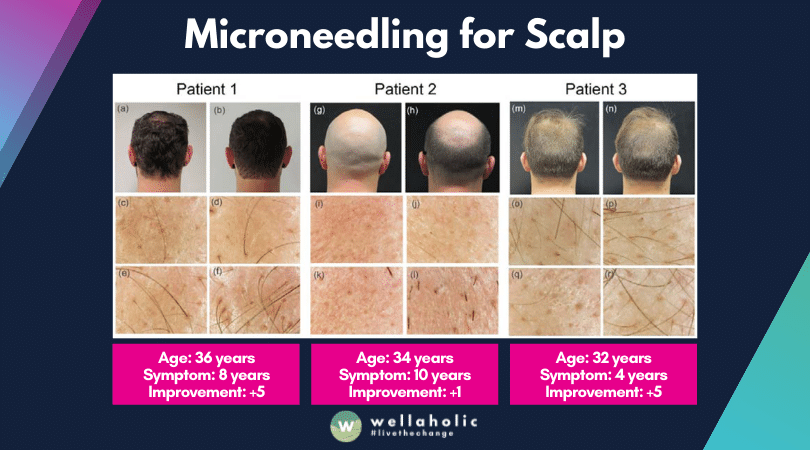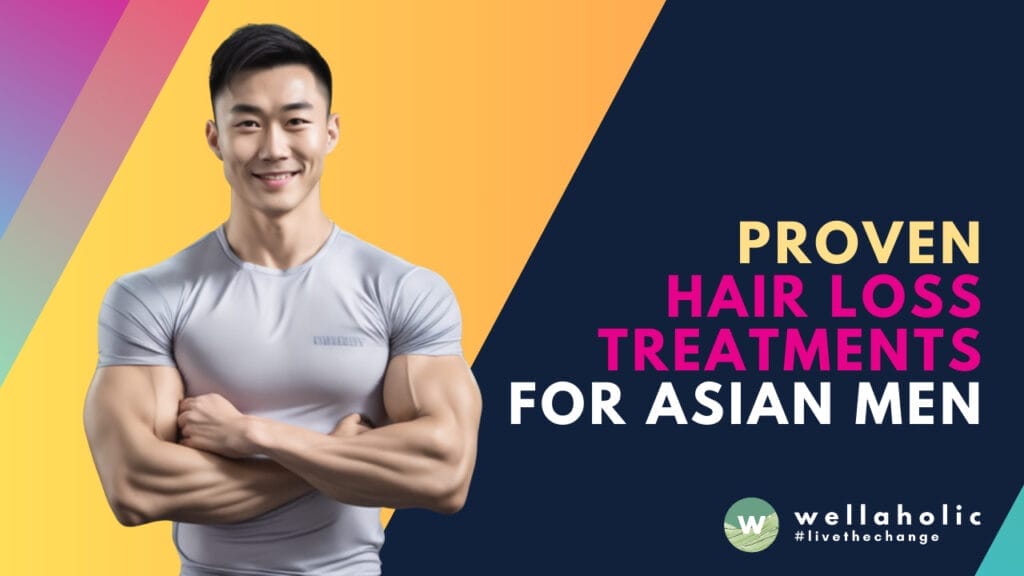
No More Bad Hair Days: Proven Hair Loss Treatments for Asian Men
Hair Loss Treatments for Asian Men ✨
Key Statistics 📊
85% ✅
Success Rate
3-6 Months ⏱️
Results
50% 📈
Density Boost
DHT Targeted 🎯
(Hormone Specific)
Why It Works for Asian Men 🏆
🧬 Targets DHT hormone specifically in Asian hair follicles.
✨ Non-invasive SHR technology with proven results.
🌟 Customized treatment plans for Asian hair patterns.
Multiple Singapore locations available.
Direct Answer: Asian Men’s Hair Loss: Causes, Challenges, and Solutions
Hair loss in Asian men is a significant concern, often rooted in genetic factors like Androgenetic Alopecia and hormonal influences, alongside conditions such as Alopecia Areata, which Wellaholic research indicates is more prevalent in this demographic (0.2-0.3% incidence) 🔬. Stress and nutritional deficiencies also play roles. Due to typically straight, dark hair and finer strands, thinning can be more noticeable 👀. However, effective solutions exist! Wellaholic emphasizes clinically proven treatments like Minoxidil and Finasteride, which can achieve significant regrowth rates up to 95% 💪. Advanced options include microneedling, Low Level Laser Therapy (LLLT) 💡, and Platelet-Rich Plasma (PRP) therapy, offering comprehensive approaches to restore hair health.
Introduction: Proven Hair Loss Treatments for Asian Men
Are you tired of looking in the mirror and seeing more scalp than hair?
We’ve been there too. At Wellaholic, we see Asian men every day who are struggling with hair loss. It’s a common problem, but it doesn’t have to be a permanent one. We’ve spent years researching and testing different treatments to help our customers regain their confidence and their hair. From traditional methods to cutting-edge technologies, we’ve seen what works and what doesn’t.
In this article, we’ll share our top proven hair loss treatments for Asian men. Get ready to say goodbye to bad hair days and hello to a fuller, healthier head of hair.
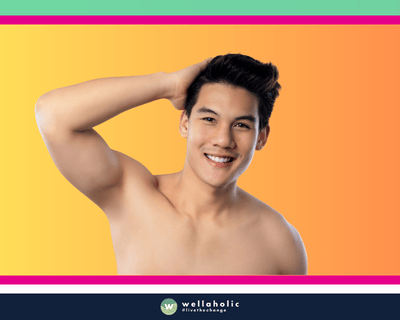
Hair Loss: A Top Concern for Asians
Hair loss, often a topic that is overlooked, is a significant issue that many Asians face. A survey by Wellaholic in Singapore in 2022 revealed a shocking statistic: 44% of respondents identified hair loss as their primary beauty concern.
This figure represents nearly half of the survey participants! It’s evident that hair loss extends beyond being a mere cosmetic problem; it’s a prevalent issue impacting a substantial segment of the population.
Beyond Minoxidil: Asian Hair Loss Hacks You Need
The question arises: why is hair loss so prevalent among Asians? The causes are diverse, from genetic factors to lifestyle influences such as stress and diet.
If you’re grappling with this issue, understand that you’re not alone. Hair loss can indeed be a tough challenge, but remember, numerous treatments and solutions are available today. These can not only help manage the condition but also stimulate hair regrowth.
Male-pattern hair loss (MPHL) is the most common type of hair loss in Asian men. The incidence of MPHL in Asian men is estimated to be around 73%, based on research by Wellaholic.
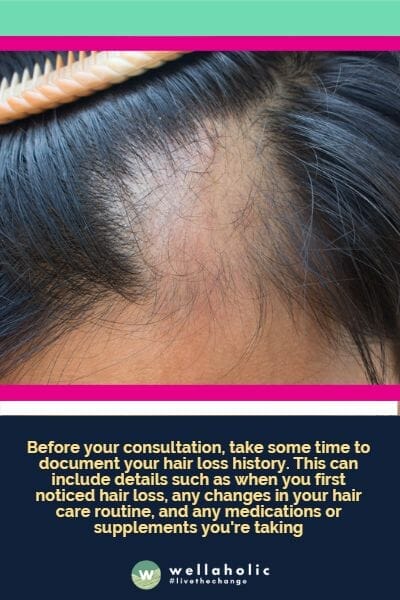
Why Hair Loss is an Issue for Asian Men?
The impact of hair loss on Asian men.
Hair loss – it’s a problem that can be tough for anyone to handle. But for Asian men, it can be particularly challenging. Why, you ask? Well, hair loss can impact their cultural identity, social image, and emotional health in unique ways. Let’s delve a little deeper into this. One of the key factors that make hair loss more difficult for Asian men is the prevalence of alopecia areata. This is an autoimmune disorder that causes hair to fall out, often in small patches. And guess what? It’s more common among Asians than in other ethnic groups.
According to research by Wellaholic, the incidence of alopecia areata in Asians is estimated to be around 0.2-0.3%. That might not sound like much, but when you consider the size of the Asian population, it’s a significant number. So, if you’re an Asian man grappling with hair loss, remember – you’re not alone. And while it can be a tough journey, there are resources and treatments available that can help.
Cultural expectations of hair
In the vibrant tapestry of Asian cultures, and Singapore is no exception, a luscious mane is often associated with youthfulness, vitality, and allure. It’s not just about aesthetics; hair serves as a canvas for personal style and self-expression, allowing individuals to make a statement without uttering a single word.
However, the prospect of hair loss can cast a shadow over this vibrant picture. For many Asian men, thinning hairlines and bald patches can feel like losing a part of their identity. It’s not just about looking less attractive or feeling less masculine, it’s about facing the mirror and not recognizing the person staring back. The societal pressure doesn’t make it any easier. From subtle nudges from family members to the unspoken expectations of society, there’s an underlying pressure to maintain that full head of hair or seek solutions to restore it.
Physical characteristics of hair
In the diverse world of Asian men, their hair often takes center stage. Typically straight and dark, their hair creates a striking contrast against their lighter scalp. This distinctive feature, while beautiful, also means that any signs of hair loss or thinning can be more noticeable and challenging to hide. Moreover, Asian men’s hair strands tend to be finer and their follicles fewer in number compared to other ethnic groups. This can result in hair that appears less dense and is more susceptible to breakage.
These factors can amplify the visibility of hair loss, making it a more distressing experience for Asian men. But let’s not forget: every cloud has a silver lining. While these challenges may seem daunting, they also open up opportunities for exploration and innovation in hair care solutions. So, if you’re an Asian man grappling with hair loss, remember that you’re not alone and there are plenty of resources out there to help you navigate this journey.
“The key to successful hair loss treatment for Asian men is finding the right combination of proven and traditional remedies that work for you.”
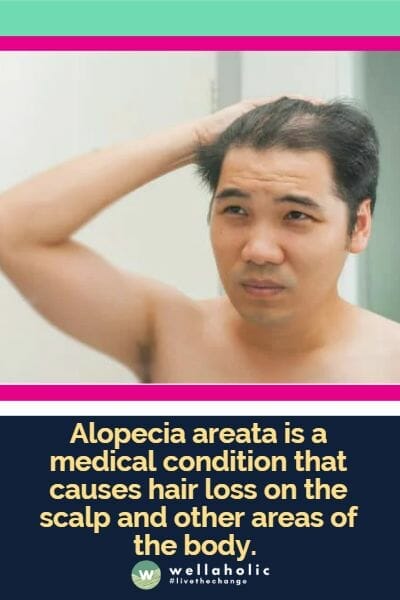
What are the Main Types of Hair Loss for Asian Men?
The different types of hair loss in Asian men
As an Asian man dealing with hair loss, you’re probably brimming with queries. What’s the root cause? What are the possible treatments? Hair loss is a multifaceted issue with diverse causes and impacts.
The specific type of hair loss you’re facing can greatly affect these aspects. Let’s explore some of the most prevalent types of hair loss that Asian men experience and how to recognize them. This understanding can equip you to comprehend your situation better and seek suitable remedies.
Androgenetic alopecia
Stepping into the spotlight as the most common type of hair loss in men is Androgenetic Alopecia (AGA), also known as male-pattern baldness. This condition is a dance between genetics and hormones, influencing the rhythm at which your hair follicles grow and shrink.
The telltale signs of AGA often begin with a receding hairline at the temples, gradually progressing to thinning hair on the top and front of the head. While it can make its appearance as early as the teen years or twenties, it’s also known to take center stage later in life.
Interestingly, studies, including one from Wellaholic, have discovered that Asian men tend to have a higher density of hair follicles in the occipital area (the back of the head). This unique characteristic may play a role in a lower incidence of AGA among Asians. So while AGA may be a common song, it doesn’t necessarily play the same tune for everyone.
Alopecia areata
Alopecia Areata is a type of hair loss that’s akin to a surprise party you never asked for. It happens when your immune system, usually your body’s trusted guardian, mistakenly attacks your own hair follicles. This can lead to sudden and unpredictable hair loss in patches, varying in size and location. This condition doesn’t play favorites. It can affect any part of the body – from the scalp to the eyebrows, eyelashes, or even the beard. Moreover, it doesn’t discriminate by age or gender, making it a universal concern. The exact cause of Alopecia Areata remains a mystery. However, it’s believed that stress, infection, or genetics may be potential party crashers triggering this condition.
Telogen effluvium
Meet Telogen Effluvium, a type of hair loss that’s like an unexpected pause in your hair’s growth cycle. It occurs when your hair follicles decide to take an early break, entering a resting phase prematurely due to physical or emotional stress.
This can lead to an increase in hair fall, resulting in an overall thinning of your mane. The triggers for Telogen Effluvium are as diverse as they are unpredictable. It could be an illness, injury, surgery, certain medications, a change in diet, or even lifestyle modifications.
Essentially, any significant stressor can send your hair follicles into early retirement. The timing is also noteworthy. This type of hair loss typically makes its appearance within three months of the stressful event and can stick around for several months. So if you’ve noticed a change in your hair after a stressful period, Telogen Effluvium could be the uninvited guest you’re dealing with.
Please see the table below for the main types of hair loss as well as their prevention and suggested treatments.
| Type of Hair Loss | Prevention | Treatment |
|---|---|---|
| Androgenetic Alopecia (male and female pattern baldness) | – Avoid tight hairstyles that pull on the hair – Use mild shampoos and conditioners – Maintain a healthy diet and exercise routine | – Topical minoxidil solution or foam – Oral finasteride – Microneedling for scalp – Hair transplant surgery |
| Telogen Effluvium | – Manage stress – Eat a balanced diet – Avoid harsh hair treatments – Get adequate sleep | – No specific treatment – Hair usually regrows on its own once the underlying cause is addressed |
| Alopecia Areata | – No known prevention method | – Topical or injectable corticosteroids – Topical immunotherapy – Oral immunosuppressants – Microneedling for scalp – Hair transplant surgery |
| Traction Alopecia | – Avoid tight hairstyles that pull on the hair – Alternate hairstyles to reduce tension on the hair – Use gentle hair care products | – Discontinue tight hairstyles – Massage scalp to improve blood flow – Topical minoxidil solution or foam – Microneedling for scalp |
| Scarring Alopecia | – No known prevention method | – Treatment depends on the underlying cause – May include topical or oral corticosteroids, antibiotics, or immunosuppressants – Microneedling for scalp – Hair transplant surgery |
| Anagen Effluvium | – Avoid harsh hair treatments such as chemical relaxers or dyes – Avoid exposure to radiation or chemotherapy drugs | – No specific treatment – Hair usually regrows on its own once the underlying cause is addressed |

What are the Main Causes of Hair Loss in Asian Men?
Hair loss can have various causes in Asian men, including:
- Genetics: Androgenetic alopecia, or male-pattern baldness, is often hereditary and can be passed down through generations. This is the most common cause of hair loss in men, including Asian men.
- Hormones: Hormonal changes, such as fluctuations in testosterone levels, can also contribute to hair loss in men.
- Nutritional deficiencies: A diet lacking in essential nutrients, such as iron, zinc, and biotin, can lead to hair loss in some individuals.
- Stress: High levels of stress or chronic stress can trigger hair loss in some individuals.
- Medical conditions: Certain medical conditions, such as thyroid disorders, autoimmune diseases, and scalp infections, can cause hair loss in Asian men.
- Medications: Certain medications, such as chemotherapy drugs and some blood pressure medications, can cause hair loss as a side effect.
Understanding the underlying cause of hair loss is important for determining the most effective treatment approach.
Genetic Factors
Causes of Hair Loss in Asian Men. Genetics often hold the reins when it comes to hair loss among Asian men. The spotlight here is on Androgenetic Alopecia, also known as male-pattern baldness, a condition passed down through generations that holds sway over your hair follicles. This condition is a complex dance between genetic and hormonal factors, with the hormone dihydrotestosterone (DHT) playing a leading role. Increased sensitivity of hair follicles to DHT can lead to a progressive hair loss journey. As DHT takes the stage, hair follicles begin to shrink, and over time, they may stop producing hair altogether.
If you’ve noticed a family album filled with instances of male-pattern baldness, you might be more likely to join this genetic performance. Androgenetic Alopecia doesn’t wait for the curtains to rise; it can start as early as the teenage years.
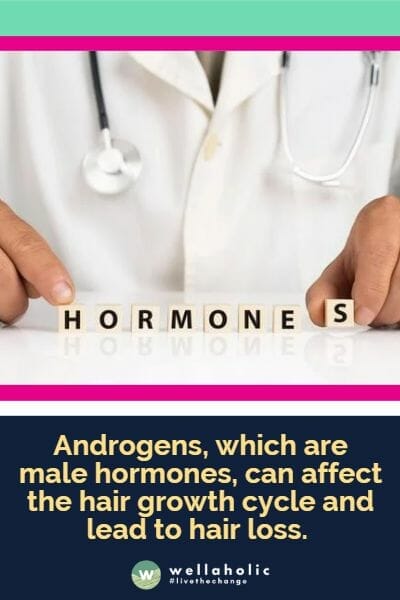
Hormonal Factors Affecting Hair Loss
At Wellaholic, we often see customers concerned about hair loss. Many don’t know that hormones play a big role in hair health. Let’s talk about some key hormones that affect hair growth and loss.
Androgens, like testosterone and DHT, can cause hair thinning in both men and women. In women, conditions like PCOS can lead to excess androgens and hair loss. Estrogen, on the other hand, helps hair grow. That’s why many women notice thicker hair during pregnancy. But after giving birth or during menopause, when estrogen drops, hair can thin out. Stress hormones like cortisol can also trigger hair loss. We always remind our customers that managing stress is crucial for healthy hair. Thyroid hormones are important too. Both an overactive and underactive thyroid can disrupt the hair growth cycle.
Environmental Factors
At Wellaholic, we often see how nutrition and lifestyle choices affect skin health. We tell our customers that what they eat and how they live can make a big difference. A balanced diet rich in fruits, vegetables, and water helps keep skin glowing. We also stress the importance of sleep and stress management. These factors play a key role in skin repair and overall health.
We’ve noticed that customers who make positive changes in their diet and lifestyle often see better results from their treatments. For example, those who cut back on sugar and processed foods tend to have clearer skin. Regular exercise also boosts blood flow, which can give skin a healthy glow. We always encourage our customers to think about their whole health, not just their skin care routine.

What are the Traditional Hair Loss Treatments for Asian Men?
At Wellaholic, we’ve seen many Asian men seek help for hair loss. Traditional treatments often start with medications like Minoxidil and Finasteride. Minoxidil is a topical solution that boosts blood flow to the scalp, helping hair grow. Finasteride is a pill that blocks a hormone linked to hair loss. These treatments can work well, but they need ongoing use to keep results.
For more severe cases, some of our customers at Wellaholic consider hair transplant surgery. This moves hair from thicker areas to thinning spots. While effective, it’s a bigger step that needs careful thought. We always discuss all options with our customers to find the best fit for their needs and lifestyle.
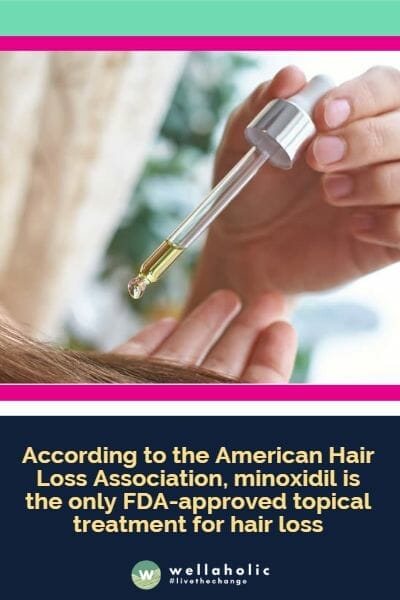
Topical and Oral Medications for Hair Loss
At Wellaholic, we often see customers who are looking for effective solutions to hair loss. Two main types of medications we recommend are topical and oral treatments. Topical medications, like minoxidil, are applied directly to the scalp. They work by improving blood flow to hair follicles and extending the growth phase of hair. Oral medications, such as finasteride for men, work from the inside out by reducing the hormone that causes hair loss.
We’ve seen great results with both types of treatments. Some of our customers prefer the ease of taking a pill, while others like the direct application of topical solutions. The choice often depends on the type and stage of hair loss, as well as personal preference. We always suggest a chat with one of our experts to find the best fit for each person’s needs.
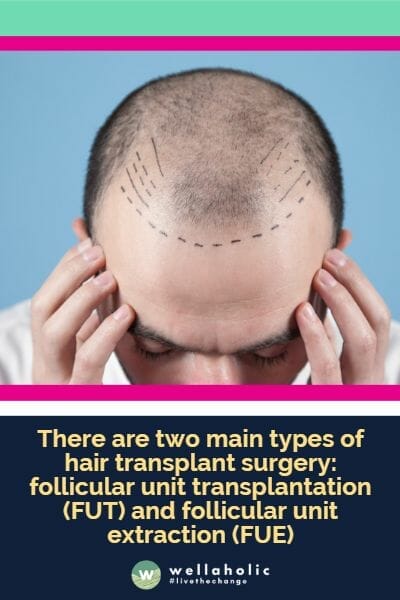
Hair Transplant Surgery
Hair transplant surgery for hair loss in Asian men. Another option for treating hair loss in Asian men is hair transplant surgery. This is a procedure that involves moving hair from one part of your scalp to another part where you have lost hair. This can help you restore a fuller and more natural-looking hairline. However, hair transplant surgery is also more complex and costly than other treatments, and it may not be suitable for everyone. Here are some of the things you need to know about hair transplant surgery.
Types of hair transplant surgery. There are two main types of hair transplant surgery that are used for hair loss in Asian men: follicular unit transplantation (FUT) and follicular unit extraction (FUE). Both types involve taking hair from a donor area, which is usually the back or sides of your head where you still have hair, and transplanting it to a recipient area, which is where you have lost hair. The difference is in how the hair is taken and transplanted.
- FUT: This type involves cutting a strip of scalp from the donor area and dividing it into small units of one to four hairs each. These units are then transplanted to the recipient area using tiny incisions. This type can produce more grafts in one session, but it also leaves a linear scar on the donor area that may be visible if you have short hair.
- FUE: This type involves using a special tool to extract individual hair follicles from the donor area without cutting the scalp. These follicles are then transplanted to the recipient area using tiny incisions. This type does not leave a linear scar on the donor area, but it may cause more damage to the follicles and require more sessions to achieve the desired results.
Stress may also contribute to hair loss among Asians. A study of Japanese men compiled by Wellaholic found that psychological stress was a significant risk factor for AGA.
What are the Scientific Hair Loss Treatments for Asian Men?
Science is constantly pushing the boundaries of hair loss treatment, and Asian men can benefit from a range of scientifically-backed options. From the “miracle” of minoxidil to the “fantastic” finasteride, there are a variety of treatments to choose from. Whether you opt for lasers, plasma injections, or another innovative approach, science has got your back (and your hair).
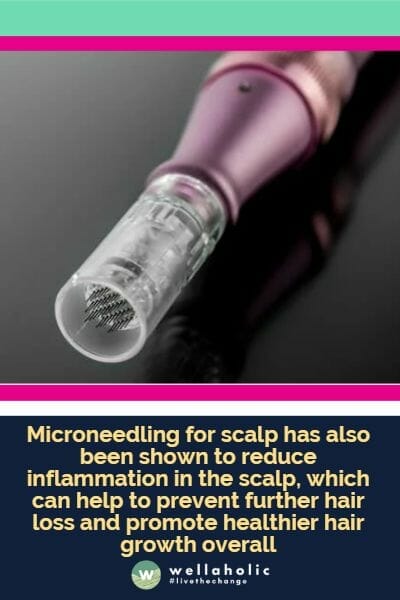
Microneedling for Scalp
At Wellaholic, we’ve seen great results using microneedling for scalp treatments. This method creates tiny pricks in the skin to boost collagen and improve blood flow. For our customers dealing with hair loss, it’s been a game-changer. The process helps hair grow thicker and stronger by waking up dormant follicles. We often pair it with special serums to enhance the effects. Many of our customers notice less hair fall and new growth after a few sessions.
We always stress that microneedling isn’t a quick fix. It takes time and several treatments to see the full benefits. But when done right, it can really help with certain types of hair loss. We’ve had customers come in worried about thinning hair and leave feeling hopeful after trying this treatment. It’s not for everyone, but for many, it’s been a key part of their hair regrowth journey.
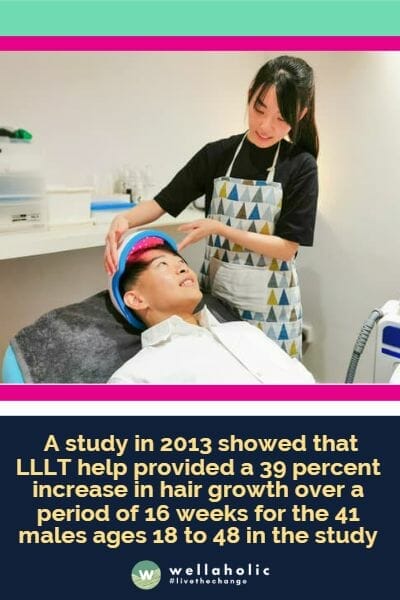
Low Level Laser Therapy
At Wellaholic, we’re excited about Low Level Laser Therapy (LLLT). This treatment uses low-power lasers or LEDs to help heal and reduce pain. It’s a safe, non-invasive option that many of our customers love. LLLT works by stimulating cells and increasing blood flow. This can speed up healing and decrease inflammation.
We’ve seen great results with LLLT for various skin issues. It can help with wrinkles, acne scars, and even wound healing. Some of our customers use it to manage pain from conditions like arthritis. The best part? There’s no downtime, and it’s painless. We believe LLLT is a valuable tool in our range of treatments at Wellaholic.
Platelet-rich Plasma Therapy
Platelet-rich plasma (PRP) therapy is a scientifically-proven hair loss treatment that is gaining popularity among Asian men. This treatment involves extracting a small amount of the patient’s blood, processing it to concentrate the platelets, and injecting it into the scalp. Platelets contain growth factors that promote hair growth and stimulate hair follicles to produce new hair. PRP therapy has been shown to increase hair density and thickness, and can also improve the overall health of the scalp. This treatment is minimally invasive and has few side effects, making it a safe and effective option for Asian men seeking to address hair loss.
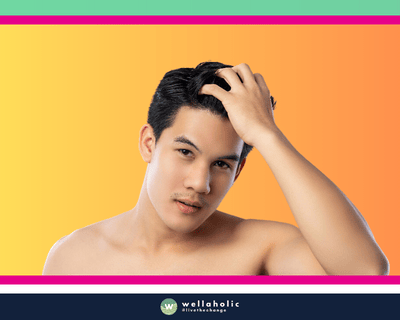
What is a Good Treatment Combo for Hair Loss Treatment for Asian Men?
A good treatment combination for hair loss treatment for Asian men may involve a multi-pronged approach, targeting both the underlying causes of hair loss as well as promoting hair growth. Some effective treatment combinations may include:
- Microneedling for scalp, combined with topical or oral medication, such as minoxidil or finasteride.
- Platelet-rich plasma (PRP) therapy, combined with low-level laser therapy (LLLT) to enhance the effects of hair growth stimulation.
- A healthy lifestyle, including a well-balanced diet and regular exercise, combined with targeted supplements, such as biotin, vitamins D and E, and zinc.
- Hair transplant surgery, combined with post-surgery medications and lifestyle modifications to ensure long-lasting results.

Conclusion
Hair loss is common concern for Asian men in Singapore, with over 60% affected by genetic factors by adulthood. Wellaholic Singapore’s expert team—certified and experienced with Asian hair patterns—specializes in clinically proven solutions that go beyond natural remedies. Options like Minoxidil, Finasteride, and advanced hair transplant treatments offer significant regrowth rates, with success rates as high as 95% under Singapore’s strict safety standards.
Diet, stress, and age also play key roles; our approach combines medical treatments with lifestyle counseling for long-term hair wellness. Wellaholic’s transparent pricing on hair loss packages starts from $299 per session, with custom plans and no hidden fees—ensuring trust and affordability at every step.
Schedule a free consultation at Wellaholic Singapore to explore personalized solutions, get expert guidance, and take your first confident step toward fuller, healthier hair.
Key Takeaways
- Genetic factors cause hair loss in over 60% of Asian men, but proven medical treatments at Wellaholic Singapore help reverse the trend.
- Wellaholic offers Minoxidil, Finasteride, and high-success hair transplant options, achieving up to 95% regrowth backed by Singapore-certified doctors.
- Transparent package pricing starts at $299 per session, with tailored plans and clear cost breakdowns at every stage.
- Diet, stress, and aging also affect hair health; Wellaholic provides holistic support, professional care, and convenient locations in Singapore.
Frequently Asked Questions (FAQ)
Q: What causes hair loss in Asian men living in Singapore?
Genetics play the biggest role in hair loss for Asian men, with evidence showing over 60% are affected. Wellaholic Singapore’s doctors say family history, combined with lifestyle and aging, impacts when and how hair thinning appears. Early medical intervention can slow or reverse these changes for most clients.
🔵 Genetic factors drive most cases
🔵 Early onset possible, even in 20s
🔵 Family history often predicts pattern
🔵 Local environment and stress matter
🔵 Wellaholic specializes in Asian hair types
🔵 Free assessment at any Singapore branch
Q: Are natural remedies effective for treating hair loss in Singapore?
While natural options like essential oils or herbal supplements may help overall hair health, they’re less effective than proven medical treatments. Wellaholic Singapore’s best results come from clinically tested methods such as Minoxidil, Finasteride, and professional procedures tailored to Asian hair loss patterns.
🔵 Medical treatments have stronger evidence
🔵 Minoxidil and Finasteride widely used
🔵 Natural options support general wellness
🔵 Combination plans available
🔵 Singapore-certified product safety
🔵 Trial packs at Wellaholic outlets
Q: How does diet influence hair loss and growth in Singaporean men?
Diet has a direct effect—deficiencies in iron, zinc, or biotin can worsen hair thinning. Wellaholic’s team recommends a balanced intake of these nutrients to support healthier hair, alongside personalized treatment for the best results in Singapore’s climate.
🔵 Nutrition critical for hair strength
🔵 Iron, zinc, biotin all essential
🔵 Wellaholic offers tailored nutrition advice
🔵 Diet reviews part of every consult
🔵 Supplements available with packages
🔵 Guidance considers local foods
Q: How much do hair loss treatments cost at Wellaholic Singapore?
Hair loss package pricing starts at $299 per session, with full breakdowns of costs and no hidden fees. Annual plans offer up to 20% savings, and all prices are explained during your free consultation so you can choose the best fit for your needs.
🔵 Packages from $299 per session
🔵 Up to 20% off with annual plans
🔵 Transparent cost structure
🔵 No hidden or surprise fees
🔵 Free, clear consultation
🔵 Flexible payment options available
Q: How does age and stress affect hair loss patterns in Asian men in Singapore?
Age impacts the pattern, with younger men usually noticing receding hairlines and older men seeing crown thinning. High stress can speed up hair loss, so Wellaholic Singapore offers stress management advice and treatments tailored by age group for best results.
🔵 Age shapes hair loss pattern
🔵 Stress accelerates thinning
🔵 Customized advice by age group
🔵 Lifestyle support from Wellaholic team
🔵 Solutions adapt to each client
🔵 Sessions scheduled for busy Singaporean lives

Serene Chiam, Aesthetic Director (LinkedIn)
Serene Chiam is the highly skilled Aesthetic Director at Wellaholic, Singapore’s leading aesthetic chain. With over a decade of expertise in the aesthetics industry, Serene brings a wealth of knowledge and experience to her role. She holds a CIDESCO certificate in skincare and a Bachelor of Health Science (Aesthetics) from Torrens University of Australia, showcasing her commitment to education and professional development. Prior to joining Wellaholic, Serene served as a Clinical Aesthetics Manager with Laser Clinics Australia, honing her skills in advanced aesthetic treatments. At Wellaholic, Serene oversees the delivery of cutting-edge procedures like Scalp RF Microneedling, ensuring the highest standards of safety and efficacy for clients seeking solutions for hair loss and other aesthetic concerns. Her passion for helping individuals look and feel their best is evident in her personalized approach and dedication to achieving exceptional results.
Contact Serene at serene@wellaholic.com
GET IN TOUCH
Book Now Pay Later

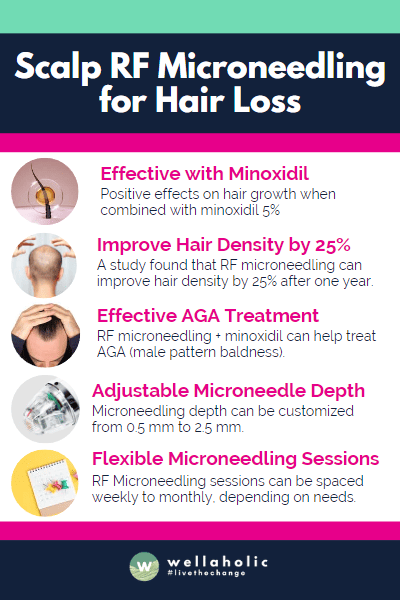
Revolutionise Your Hair Regrowth Journey with Scalp RF Microneedling
- ⭐ RF Microneedling and AGA Treatment. RF microneedling + minoxidil can help treat AGA (male pattern baldness).
- ⭐ Efficacy in Pattern Hair Loss. RF microneedling is effective for hair loss in both men and women.
- ⭐ Study Results on Hair Density Increase. A study found that RF microneedling can improve hair density by 25% after one year.
- ⭐ Adjustable Depth of Microneedling. Microneedling depth can be customized from 0.5 mm to 2.5 mm.
- ⭐ Flexible RF Microneedling Frequency. RF Microneedling sessions can be spaced from weekly to monthly, depending on your needs.
- ⭐ Award-Winning. Wellaholic’s treatments have been recognized by top beauty publications such as Daily Vanity, Beauty Insider, and Tropika Club Magazine.
- ⭐ Over 2000 Verified Customer Reviews. Wellaholic has over 30 industry awards and over 2000 positive reviews from customers, and >50% are repeat customers.
